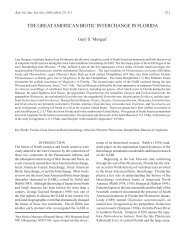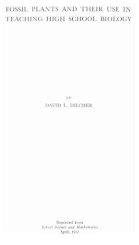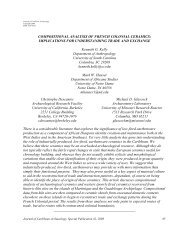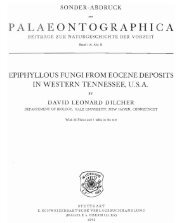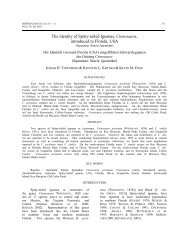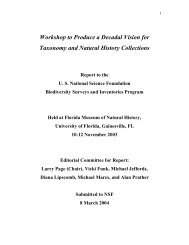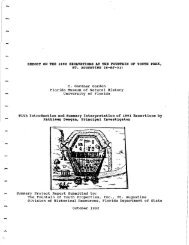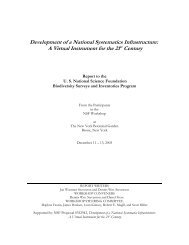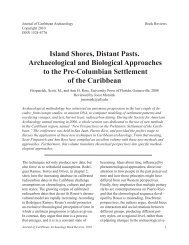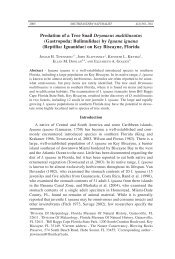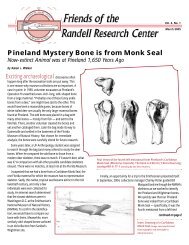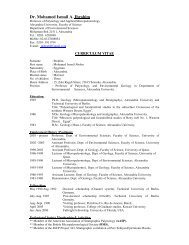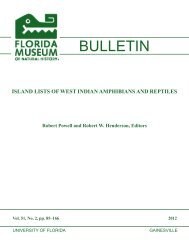Early angiosperms from the Lower Cretaceous of Jixi, eastern ...
Early angiosperms from the Lower Cretaceous of Jixi, eastern ...
Early angiosperms from the Lower Cretaceous of Jixi, eastern ...
You also want an ePaper? Increase the reach of your titles
YUMPU automatically turns print PDFs into web optimized ePapers that Google loves.
only <strong>from</strong> dispersed pollen grains.It is signi¢cant<br />
that we have <strong>the</strong> same pollen type <strong>from</strong> an in£orescence<br />
in situ which is seemingly attached to a<br />
dicotyledonous leaf.Previously it was thought<br />
that <strong>the</strong> sulcus <strong>of</strong> monosulcate angiosperm pollen<br />
were derived <strong>from</strong> a gymnosperm ancestor which<br />
had monosulcate pollen.However, Brenner proposes<br />
a new model for <strong>the</strong> evolution <strong>of</strong> <strong>the</strong> monosulcate<br />
aperture in <strong>angiosperms</strong>.He suggests that<br />
<strong>the</strong> sulcus was developed <strong>from</strong> within <strong>the</strong> angiosperm<br />
lineage and that its presence in <strong>angiosperms</strong><br />
is entirely an angiosperm feature and not<br />
derived <strong>from</strong> a non-angiospermous ancestor.The<br />
inaperturate nature <strong>of</strong> both <strong>the</strong> pollen mention<br />
here and that described by Brenner may be <strong>the</strong><br />
result <strong>of</strong> <strong>the</strong> sometimes cryptic nature <strong>of</strong> apertures<br />
in some <strong>angiosperms</strong>. Endress (1987) indicates<br />
that in some genera <strong>the</strong> apertures are <strong>of</strong>ten hidden<br />
by reticulate exine ornamentation.The occurrence<br />
<strong>of</strong> very similar, small, circular, ‘inaperturate’, reticular,<br />
tectate-columellate pollen which Brenner<br />
found as dispersed pollen in Israel, is known<br />
<strong>from</strong> a megafossil in situ in China.This new material<br />
may provide new characters useful in understanding<br />
<strong>the</strong> nature <strong>of</strong> early <strong>angiosperms</strong>.<br />
The in£orescence consists <strong>of</strong> a clustering <strong>of</strong><br />
small helically arranged £orets borne on a ra<strong>the</strong>r<br />
stout axis.Because <strong>of</strong> <strong>the</strong> carbonaceous nature <strong>of</strong><br />
<strong>the</strong> preservation and <strong>the</strong> crowded nature <strong>of</strong> <strong>the</strong><br />
£orets, it is di⁄cult to discern <strong>the</strong> nature <strong>of</strong><br />
each £oret.The parts seem to be very small, forming<br />
£orets 1.0^1.5 mm in diameter. Since <strong>the</strong> pollen<br />
are derived <strong>from</strong> <strong>the</strong> £orets in situ, we assume<br />
that <strong>the</strong>re were an<strong>the</strong>rs in <strong>the</strong> £orets, but do not<br />
know if <strong>the</strong> £orets were bisexual or unisexual.<br />
However, it seems most probable that since <strong>the</strong><br />
reproductive axis appears to be still attached to<br />
<strong>the</strong> leaf, in which axis it was borne, and because<br />
Plate V.<br />
G. Sun, D.L. Dilcher / Review <strong>of</strong> Palaeobotany and Palynology 121 (2002) 91^112 107<br />
most all <strong>of</strong> <strong>the</strong> £orets are still attached to a common<br />
axis, with no indication <strong>of</strong> fruit formation,<br />
that <strong>the</strong> £orets are young or immature.Because<br />
pollen is present and well formed, perhaps <strong>the</strong><br />
pollen bearing organs matured before <strong>the</strong> ovules.<br />
Never<strong>the</strong>less, until we can collect additional material<br />
and make more preparations, we consider<br />
that <strong>the</strong>se £orets were ei<strong>the</strong>r bisexual or male.<br />
Small bisexual £orets have been described <strong>from</strong><br />
<strong>the</strong> Albian (Friis et al., 1994) and Turonian (Crepet<br />
and Nixon, 1994) sediments in <strong>eastern</strong> North<br />
America.These £orets are small (2.2 mm), pedicellate,<br />
bear monosulcate pollen and are described<br />
as isolated £orets.The only feature similar between<br />
<strong>the</strong> fossil £orets <strong>of</strong> Virginianthus and Xingxueina<br />
is <strong>the</strong> small size <strong>of</strong> <strong>the</strong> £orets.But this is<br />
important because it indicates that several early<br />
<strong>angiosperms</strong> had £owers that were small, many<br />
<strong>of</strong> which were crowded upon an individual axis.<br />
Friis et al.(1994) compares Virginianthus with<br />
Calycanthaceae and notes many similarities between<br />
<strong>the</strong> fossil and several genera <strong>of</strong> that family,<br />
several <strong>of</strong> which have small £orets. Crepet and<br />
Nixon (1994) in <strong>the</strong>ir review <strong>of</strong> <strong>the</strong> fossil £owers<br />
<strong>of</strong> <strong>the</strong> Magnoliidae suggest that <strong>the</strong> angiosperm<br />
ancestral groups probably had small simple £owers<br />
with parts in whorls similar to that known for<br />
<strong>the</strong> Chloranthaceae, Platanaceae, Buxaceae and<br />
Lauraceae (Friis et al., 1991).Also, Dilcher<br />
(1979) suggested that early <strong>angiosperms</strong> may<br />
have had small simple £owers.The reproductive<br />
axis appears to be borne in <strong>the</strong> axil <strong>of</strong> <strong>the</strong> leaf <strong>of</strong><br />
Xingxuephyllum (Plate V, 1B, Fig.4G).There are<br />
two small carbon fragments <strong>of</strong> <strong>the</strong> petiole missing,<br />
but it appears as if <strong>the</strong> petiole continued to <strong>the</strong><br />
slightly enlarged base which is in common with<br />
<strong>the</strong> base <strong>of</strong> <strong>the</strong> reproductive axis.We also considered<br />
a possibility that <strong>the</strong> two fossils just hap-<br />
1A, 3^5. Xingxueina heilongjiangensis Sun et Dilcher.<br />
1A, 3. In£orescence, SC10025. 1A. Bar = 0.5 cm. 3. Bar = 0.2 cm.<br />
4.Pollen grain <strong>from</strong> <strong>the</strong> in£orescence.SEM0775.Bar = 10 Wm.<br />
5.Pollen grains in situ on <strong>the</strong> surface <strong>of</strong> <strong>the</strong> in£orescence as viewed by epi£uorescence microscopy, SC10025.Bar = 80<br />
Wm.<br />
1B, 2. Xingxuephyllum jixiense gen.et sp.nov.Incomplete leaf probably connected organically with <strong>the</strong> in£orescence,<br />
Holotype SC10026. 1B. Bar = 0.5 cm. 2. Bar = 0.6 cm.



